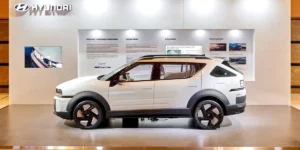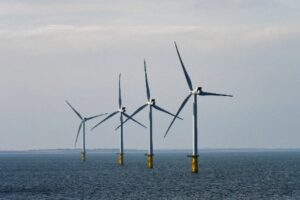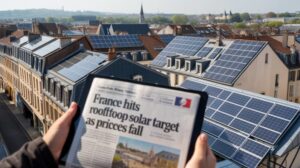‘Carbon-negative hydrogen’ | This start-up has designed technology that combines H2 production with direct air capture

Direct air capture is one of the more controversial climate solutions proposed in recent years.
While proponents warn that it will be necessary to mitigate emissions from hard-to-abate sectors in order to reach net zero by 2050, critics argue that it will be prohibitively expensive in the short term and allow industries to continue to pollute, with budgets better spent on other, more effective decarbonisation measures.
Start-up Parallel Carbon claims its patent-pending technology solves these two problems in one — capturing CO2 from the air while producing low-cost green hydrogen.
The company’s electrolyser splits a neutral-salt electrolyte into an acid at the anode and an alkali at the cathode during hydrogen production, which CEO and co-founder Ryan Anderson describes as “similar to the chlor-alkali process” but without generating chlorine gas.
On the direct air capture side, a mineral sorbent extracts CO2 from the atmosphere and is then dissolved in the acid to release the gas, either for geological storage or to be used in industrial processes. The sorbent is then re-generated with the alkali, allowing it to be re-used to capture more CO2 from the air.
This process also regenerates the electrolyte, although Anderson notes that the technology also flows “a fair amount more water than traditional electrolysers”.
Article continues below the advert
Even though the electrolyser may operate intermittently, the acids and alkalis for recycling the mineral sorbent can be overproduced and stored to continue to run the direct air capture process even when renewable power is not available.
Anderson says: “We actually designed our technology to be a flexible industrial load, meaning that we’re trying to run our entire operations on intermittent power to ensure we can meet the temporal, spatial, and additionality requirements of 45V [the US clean hydrogen production tax credit], as well as the ability to guarantee we are not inadvertently creating marginal electricity emissions for the carbon accounting in the direct air capture process.”
“For most direct air capture, operating with clean power is a necessity — I think that’s very challenging for other direct air capture technologies,” he adds, noting that “over 90% of the energy for the process goes into the electrolyser”, which is designed to run on a wider operating range than alkaline equivalents while being roughly the same capital cost.
However, the technology does require more energy input than conventional electrolysers, since it is also running direct air capture, potentially making the process more reliant on low power prices.
Anderson estimates that for $30/MWh of renewable electricity bought to power the process, the energy costs would work out to $1.50 per kg of H2 and $50 per tonne of CO2, although he expects that because the process has two products — hydrogen and captured CO2 — this gives the company flexibility in how costs are ascribed between electrolysis and direct air capture.
“For instance, the energy costs could alternatively be described as $1/kgH2 and $75 per tonne of CO2, providing a competitive hydrogen pricing advantage against even the most efficient electrolysers,” he adds.
Parallel Carbon more broadly targets a levelised cost of $400 per tonne of CO2 captured and $2/kgH2 produced by the late 2020s, with a further ambition to drive these down to $100 and $1 respectively in the early 2030s.
The start-up, which has already raised $3.6m in seed funding led by Aramco Ventures, plans to launch a stack in the scale of “a couple hundred kilowatts” for testing in the field by early 2025, which will be capable of producing around 50kg of hydrogen and capturing one tonne of CO2 per day.
“We’ve pre-sold our [carbon dioxide removal (CDR)] credits through the end of 2025 for operations that will begin in 2025. So we’ve sold our first year of operations to get us off the ground, to get our project built,” Anderson adds.
As 2030 interim climate targets loom for major corporations, many have turned to the voluntary carbon market, which trade credits based on carbon removals or environmental protection, such as via preventing deforestation.
However, greater scrutiny is being placed on how much CO2 is actually removed from the atmosphere as a result of this market, with an investigation led by UK newspaper The Guardian last year arguing that more than 90% of credits certified by Verra did not represent carbon reductions.
“There’s a lot of ways this is going wrong, but there are very clear ways to make sure you’re doing it right,” says Anderson, who had previously worked as an analyst on carbon capture and storage (CCS) for research house BloombergNEF.
“When it comes to direct air carbon capture, where you can measurably pull CO2 out of the air, verify how much CO2 is being pulled out and stored in concrete or injected underground, you know that this CO2 is being stored with high permanence and long durability.
“You can ensure basically every step along the way that you are paying for high-quality climate action.
“I think the challenge for direct air capture in the voluntary carbon market world is pricing. No-one wants to pay thousands and thousands of dollars per tonne, even though some are willing to for smaller-scale projects to get them off the ground and see how the technology develops.”
But for hard-to-abate sectors such as steel, why invest billions of dollars toward switching their processes to run on hydrogen to mitigate carbon prices, when they could simply buy CDR credits and run business as usual?
“That’s largely what we’re trying to solve, right?” said Anderson. “We’re trying to say, ‘let’s make you carbon-negative hydrogen, that way you can decarbonise your steel and also if you have other supply chain or residual emissions, use the carbon removal credits towards those so you can hit net zero faster and more cost effectively’.”
However, he is sceptical that industries will opt for carbon removal over investing in other decarbonisation methods, in part because the actual quantity of high-quality credits on the market over the next 10 to 15 years will be relatively small.
Due to this limit on supply, as well as the understanding that carbon removal will be the last resort, Anderson points out that companies offering credits will have little reason to try and undercut other emissions reductions methods on price.
“If I see it costs $300 per tonne [CO2] for a steel manufacturer to decarbonise, why would I charge them significantly less than that to use direct capture for CDR?”
Beyond a growing carbon credit market, direct air capture also benefits from extremely lucrative subsidies in the US.
The 45Q tax credit offers $85 per tonne of CO2 from point-source carbon capture that is permanently stored ($60 if the gas is used in industry or for enhanced oil recovery), which balloons to $180 (or $130) if direct air capture is used — although this process needs to capture at least 1,000 tonnes of CO2 a year to qualify.
However, Anderson notes that this starts to get complicated if Parallel Carbon or producers using its technology wanted to also claim the 45V clean hydrogen production tax credit, which offers a top rate of $3/kg based on a strict limit of lifecycle greenhouse gas emissions.
“You’re not allowed to take them together, right? If you’re doing one process, you don’t get the other tax credit,” Anderson says. However, he adds that unlike blue hydrogen, the actual H2 production process itself does not rely on CCS to claim zero emissions, and suggests that a structure wherein one company owns the electrolyser and supplies acids and alkalis for direct air capture to a separate firm could allow each to claim their respective tax credits.
Hydrogen Insight understands that currently, no facility producing H2 can claim both the 45Q and 45V, even if the equipment for hydrogen production and carbon capture are owned by separate companies — although it is unclear whether this would apply to by-products of electrolysis sold to CCS companies.
But even assuming only one tax credit will apply, assuming a similar proportion of hydrogen production to direct air capture to the planned pilot in 2025, Hydrogen Insight calculates the 45Q tax credit would still pay out $3.6/kg H2 if the carbon was geologically stored — more than the $3/kg top rate of the 45V tax credit.
Even without subsidies, Anderson estimates that carbon credits on the market from direct air capture are currently sold for more than $600 per tonne of CO2.
When it comes to revenue, the Parallel Carbon CEO notes that “right now, today, we own the entire process”, from manufacturing and operating the electrolyser to the direct air capture equipment.
But while the start-up is looking to partner with larger electrolyser manufacturers on that side of the technology, “we intend to own and operate the direct air capture process”, Anderson adds, noting that there is “a lot of optionality in how these get deployed”.
Parallel Carbon is also looking towards a larger, commercial pilot in 2026 — capable of producing 100 tonnes of hydrogen and capturing 1,000-2,000 tonnes of CO2 per year — following a planned Series A fundraising round.
“That 2026 project is where we’ll start working with large hydrogen project developers to potentially get our electrolyser onto their site, and then we can figure out the CO2 aspect of this during that time — whether that’s delivering CO2 on-site or if it’s taking the acids and bases [ie, alkalis] or CO2 off-site and delivering it elsewhere,” Anderson says.






